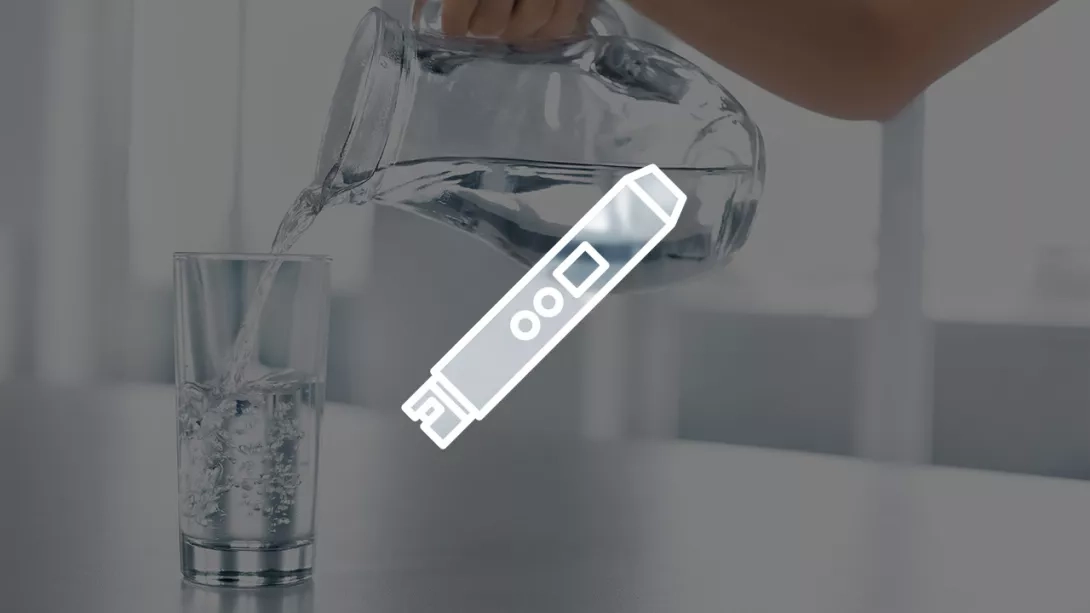Often, our clients ask this question after purchasing a reverse osmosis system, so today we'll discuss the reasons for this phenomenon and whether any actions are necessary to change the situation.
What is TDS and ppm?
TDS (Total Dissolved Solids) refers to the total content of dissolved inorganic and, to a lesser extent, organic salts in water. ppm (parts per million) is the unit of measurement for salt content, usually denoted as mg/L or mg/dm³.
The ions that make the most significant contribution to the overall salt content are:
- Cations: Sodium, Potassium, Calcium, Magnesium.
- Anions: Carbonates, Bicarbonates, Sulfates, and Nitrates.
To measure the total salt content, a special device called a TDS meter or salinometer is used. Its operation is based on the conductometry method, meaning the device determines the electrical conductivity of the solution and converts it into the total salt content, expressed in ppm (mg/L).
It is important to note that a TDS meter is more of a device that helps quickly but indirectly assess water quality.
The analogous indicator in the drinking water quality standard is the "dry residue" since the total dissolved solids content in standardized methods is determined by evaporation.
We have previously written in detail about methods for determining water quality indicators at home.
What Should the TDS Level Be After Osmosis?

Under ideal working conditions (water composition and temperature), reverse osmosis membranes provide a 98-99% reduction in salts. Additionally, some pollutants are retained at the initial filtration stages—mechanical and carbon cartridges.
If everything is working correctly, the water quality after osmosis should be as follows:
| Parameter | Value |
|---|---|
| pH | 5.5 - 6.5 |
| TDS, mg/L | 5 - 15 |
| Calcium | <2 |
| Magnesium | <1 |
| Sodium + Potassium | <5 |
Normal TDS Value After a Filter with a Mineralizer
During mineralization, water with a low pH passes through an additional filter containing natural minerals, most commonly calcite. Due to the acidic environment, the water actively dissolves calcium and magnesium salts, becoming saturated with calcium and magnesium ions. As a result, water after Ecosoft reverse osmosis systems meets the following standards:
| Parameter | Standard/Absolute | P’URE Balance | AquaCalcium |
|---|---|---|---|
| pH | 6.5 - 7.5 | 7.0 - 8.5 | 7.0 - 7.5 |
| Mineralization, mg/L | 20 - 30 | 60 - 80 | 55 - 65 |
| Calcium | <10 | 10 - 15 | 10 - 15 |
| Magnesium | – | 4 - 6 | – |
Since natural minerals are used in the mineralization process, values may slightly exceed the norm immediately after installing a new mineralizer or when pouring the first portion of water. This phenomenon is within the norm, as at the very beginning of use, minerals may have a slightly more active surface, and therefore, dissolve better. Moreover, longer interaction of water with them during idle periods allows the water to more fully dissolve the mineralizer content.
Why is the TDS Level Higher Than Expected After Osmosis?
So, what should you do if, after measuring the TDS of the water, you see a value different from the expected 10-15 ppm after osmosis? Several reasons could lead to such outcomes:
- Change in the quality of the source water
- Change in the operating parameters of the mineralizer
- Need to replace the reverse osmosis membrane
- Error in the TDS meter operation
Let's explore these in more detail.
Change in the Quality of the Source Water
The maximum allowable dry residue for tap water is <1000 mg/L. Despite the compliance of drinking water with specified standards, this is not always the case. The quality of centralized water supply can vary depending on the season, weather conditions (snow melting, floods), as well as various emergency situations.
Besides the ability to retain salts, which characterizes the overall water purification degree, another parameter—selectivity—also plays a role. Simply put, it's the ability to retain some ions better than others. This is well illustrated in the first table above, where it shows that the total concentration of magnesium and calcium after the membrane is lower than that of sodium and potassium, which more easily "slip through" the membrane barrier. For this reason, the efficiency of the membrane is evaluated by the reduction in sodium chloride content, typically about 98% for household elements.
Time to Replace the Reverse Osmosis Membrane
If the TDS levels at the output are significantly elevated (>100 ppm) for filters without mineralization, there is a possibility that the reverse osmosis membrane has failed. Several factors can cause this:
- Low pre-filtration quality: If polypropylene and carbon cartridges at the filter input were not replaced on time or are of poor quality, the membrane could be damaged by mechanical particles and/or chlorine. In such a case, the quality of the water also plays an important role because the lower it is, the more likely it is that the cartridges will quickly exhaust their resources.
- Sudden pressure spikes in the system: This can simply "tear" the membrane, and with too low pressure, the water may not flow at all. We previously discussed what pressure should be in an osmosis tank.
- Incorrect storage conditions for the membrane element
- Manufacturer defects
Measurement Error and Tactics for Using a TDS Meter
To obtain accurate total dissolved solids values, the device must be calibrated according to the manufacturer's instructions. The measurement error of an uncalibrated device can be very significant.
The second step is correct measurement. Here are a few rules that will help you measure it correctly:
- Flush 1-2 glasses of water from the filter before taking a sample.
- Thoroughly rinse the TDS meter sensor if you plan to measure water with lower salt content.








